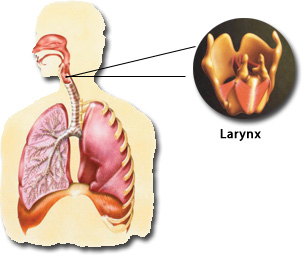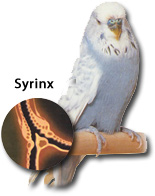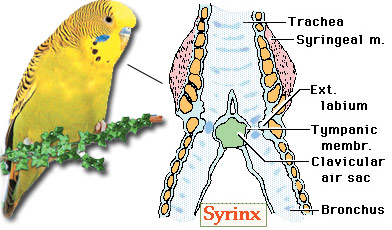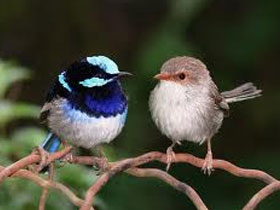The Physical Formation of Sound in Birds
You might assume that in order for a parrot to be able to imitate the human voice-to use a person's same spoken words, stresses and pronunciation-they must possess a larynx whose structure is similar to a human's. However, the structure of the human larynx bears no resemblance to these creatures' physical structures. The larynx, vocal cords, tongue, lips, palate and teeth that humans use in speech are completely different in birds, and some do not exist at all. But even though all birds lack these structures, still these species can reproduce phrases spoken by humans-and in the same tones. If we consider that a person without a tongue is unable to speak or that we lose our voice if the vocal cords are damaged, it's also worth considering that parrots, budgerigars, and mynahs, members of the crow family, have completely different physical characteristics which nevertheless enable them to talk in the same way as humans.
There are other differences between the systems that humans and birds use to produce vocal sounds. We produce most sounds d by expelling air from the lungs through the larynx. Different sounds are created, according to the degree of vibration of the vocal cords. The position of the tongue and lips and the flow of air through the mouth or nasal cavity are only a few of the many other factors affecting sound production. The pharynx, found in humans, lets the tongue divide the vocal tract above the larynx into two cavities with their own distinct resonances. Where these resonances occur, the overtones of the frequencies (or number of vibrations) from the vocal cords are amplified. Formants (from the Latin formare: to shape, or form) are resonant frequencies of the vocal tract, the natural shapes that air assumes in the vocal passage. When you make a consonant, for example, this has an effect on the formants of the neighbouring vowels, raising or lowering formants as the vowel sound gets closer to the corsonant. Experiments have shown that two formants are sufficient in order to differentiate speech sounds from each other. 5
Birds have no larynx similar to a human's, but do have a special vocal organ, known as the syrinx, that enables them to produce sounds. In birds, air from the lungs passes through this organ. In a sense, the bird's syrinx is the equivalent of our human larynx. One of the principal differences is that in humans, our vocal cords are positioned closer to the windpipe. So far, the fact that the bird's syrinx is deep inside the body has prevented scientists from obtaining a complete answer as to how birds produce sound. Scientists have filmed birds using infra-red and x-ray cameras, and have made close studies of their song and speech by means of fiber-optic microscopes inserted in their throats. Yet we still cannot explain the physical process by which birds produce song and imitate sounds.
 The human voice box is located in our throats and therefore, close to the mouth. Birds, on the other hand, have their vocal organ situated in the body. For this reason, birds' vocal organ is affected by two airflows, as opposed to just one as in humans. Muscles that open and close the airways on both sides of the organ control the beginning and end points of the vocal system. In humans, vocal sounds are produced by the flow of air from the lungs. The lungs propel air towards the voice box, and the air passing through the vocal cords there produces sounds that, in turn, are transformed into speech by means of the bronchia, the tongue, the teeth, the nasal cavity and the sinuses. |
 The two-branched syrinx, located deep in the breast of a bird, is situated where the two bronchia divide in the windpipe. In this complex system, the vocal organ's muscles and inner membranes affect the production of mid-tones. By contraction of the pectoral and stomach muscles, air is directed from the air sacs to the bronchia and the syrinx, where the air molecules vibrate as they pass through narrow passages. Vibrations of the tympana membrane also affect the frequency of the sound. The pressure of the air sacs in the clavicle in turn affects the tympana membrane. The syrinx muscles also affect the flow of air and consequently, the quality of sound. |
The syrinx is located in a pouch within the clavicle below the bird's throat. The membrane covering this pouch is sensitive to the air coming from the lungs, and its elasticity and complexity of the membrane are factors that determine the quality of sounds. The sound quality is also affected by the length of the windpipe, the constriction of the voice box, the neck muscles, structure of the beak, and their respective movements. In short, the complexity of the birds' syrinx determines the complexity of the sounds they produce. Its muscles affect the air flow and consequently, the quality of the sound. In parrots, budgerigars, and some songbirds, the syrinx has a greater number of muscles, and its structure is more complex.
Furthermore, the different techniques that parrots and budgerigars employ for imitating the human voice are most effective. Like humans, parrots have thick tongues that enable them to produce sounds resembling ours. Sound is produced by blowing air through two separate places in their syrinx, and at the same time producing the independent sounds required to produce consonants. The initial sound from the syrinx is shaped with the help of the throat, and then in the mouth with the tongue. In their research studies with grey parrots, Dianne Patterson and Irene Pepperberg reached important conclusions on vowel production: Due to the radically different anatomy of this parrot's vocal organ, even though they lack teeth and lips, they can produce sounds that closely resemble sounds produced by humans.7 Indeed, parrots and budgerigars can quite clearly imitate sounds such as "m" and "b," which we normally produce with the help of our lips.
Budgerigars, however, due to their small size, are not able to use the same technique as parrots. Using their syrinx to create frequencies from 2,000 to 3,000 Hz, they then add on a second vibration. This system is known as frequency modulation or FM, the principle behind the AM (amplitude modulation) radios to be found in practically every home. These days, many FM broadcasting stations add low transmitters to their signals which, in common with normal signals, are adjustable through a transmitter, but are of a very high frequency. While the frequency of normal signals varies from 20 to 20,000 Hz, the frequency of many low transmitters starts at 56,000 Hz. The main reason for using the FM system is to offset the major disadvantage of the AM system-namely, the interference of many natural or man-made radio sounds, called "parasites." Because the weak signals of AM radio are quieter than the stronger ones, differences in signal level are formed, which are then perceived as noise. AM receivers have no facility for cutting out these parasitic sounds.
To solve this problem, Edwin H. Armstrong invented a system for eliminating noise caused by the power of the waves. Instead of changing the transmission signal or the strength of the transmitter, he changed the frequency of sound waves per second. Thanks to this system, the amplitude of noise (strength of sound waves) could be reduced to a minimum. But scientists are still mystified how budgerigars manage to use this same system.

 The physical structures used in human speech-voice box, vocal chords, tongue, lips, palate and teeth are completely different from the structures in birds, and some are completely absent. Even though talking birds do not possess these structures, they are able to produce words and expressions used by humans, and with the same intonation.
The physical structures used in human speech-voice box, vocal chords, tongue, lips, palate and teeth are completely different from the structures in birds, and some are completely absent. Even though talking birds do not possess these structures, they are able to produce words and expressions used by humans, and with the same intonation.
To solve this problem, Edwin H. Armstrong invented a system for eliminating noise caused by the power of the waves. Instead of changing the transmission signal or the strength of the transmitter, he changed the frequency of sound waves per second. Thanks to this system, the amplitude of noise (strength of sound waves) could be reduced to a minimum. But scientists are still mystified how budgerigars manage to use this same system.
Of course, no little budgerigar can possibly work out for itself from the time it is hatched how to apply a series of principles discovered by man only after long trials. In the same way, no parrot can know that it must produce auxiliary sounds in order to make consonants distinct or to develop systems in its throat to enable it to do so. Also, it's not possible for such a system to be the end product of a series of blind coincidences. All these complex systems we have seen are without doubt, the work of God, the Creator.
Birds' Sense of Hearing
 Birds' ability to perceive sound is approximately ten times keener than ours. Birds can discern ten different sounds in what humans perceive as one note. Moreover, while humans process sounds in 1/20th of a second, birds can distinguish the same sounds in 1/200th of a second. |
For birds to display their talents in communicating by sound, song and in the case of some birds, words, they require excellent hearing. At critical times in their lives, their sense of hearing becomes particularly important. Experiments have shown that in order for birds to learn their species' song, they need an auditory feedback system. Thanks to this system, young birds learn to compare the sounds they produce themselves with the patterns of a song they have memorized. If they were deaf, it wouldn't normally be possible for them to sing recognizable songs.8
Birds' ears are well equipped for hearing, but they hear in a different way from us. For them to recognize a tune, they have to hear it in always the same octave (a series of seven notes), whereas we can recognize a tune even if we hear it in a different octave. Birds cannot, but can instead recognize timbre-a fundamental note combined with harmonies. The ability to recognize timbre and harmonic variations lets birds hear and reply to many diverse sounds, and sometimes even reproduce them.
Birds can also hear shorter notes than we can. Humans process sounds in bytes in about 1/20th of a second 9, whereas birds can distinguish these sounds in 1/200th of a second, which means that birds are superior at separating sounds that arrive in very rapid succession.10 In other words, a bird's capacity to perceive sound is approximately ten times greater, and in every note heard by a human, it can hear ten.11 Moreover, some birds are also able to hear lower sounds than we are. Their hearing sensitivity is so finely tuned that they can even tell the difference between pieces by such famous composers as Bach and Stravinsky.
Birds' extremely sensitive hearing functions perfectly. Clearly, each of this sense's components is created by special design, for if any one failed to work properly, the bird would not be able to hear anything. This point also disproves the theory that hearing evolved or emerged gradually, as a result of coincidental influences.
To purchase the works of Harun Yahya, please visit www.bookglobal.net
i http://www.linguistlist.org/~ask-ling/archive-1997.10/msg01480.html
ii http://www.eeb.uconn.edu/courses/Ornithology/EEB281_1_Vocalizations.htm
iii Lesley J. Rogers & Gisela Kaplan, Songs, Roars and Rituals, Communication In Birds, Mammals and Other Animals, USA, 2000, p. 81.
iv http://instruct1.cit.cornell.edu/courses/bionb424/students/mdr17/neurophysiology.html
v http://www.earthlife.net/birds/hearing.html
vi Theodore Xenophon Barber, Phd., The Human Nature of Birds, USA, 1993, p. 36.
vii Theodore Xenophon Barber, Phd., The Human Nature of Birds, USA, 1993, p. 37.




